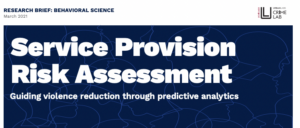Service Provision Risk Assessment (SPRA)

The Crime Lab designed the Service Provision Risk Assessment to help violence prevention organizations identify the people at the highest risk of future gun violence involvement and offer them intensive social services and supports.
Challenge
In a large city like Chicago, community-based and social service organizations face persistent challenges in identifying people who could benefit from services and assessing their gun violence risk.
Opportunity
The Crime Lab developed the SPRA tool to identify people at high risk of gun violence involvement to assist community-based and social service organizations with accessing relevant and game-changing data. Pairing practitioner knowledge with the SPRA helps organizations provide more intensive services to the people with the greatest need.
Project overview
In 2016, as gun violence surged in Chicago, the Crime Lab began developing a risk assessment tool, the SPRA, designed to help community-based organizations find the people at the highest risk of future gun violence involvement and pair them with intensive social services and supports. During development, the Crime Lab partnered with gun violence prevention groups to understand how the referrals generated from the SPRA aligned with social networks and perceived risk levels, as well as whether and how outreach workers could systematically use such referrals.
The SPRA uses data on reported arrests, victimizations, and similar information about a person’s peers to predict their risk of future gun violence involvement. This protected data is never shared publicly. Once the SPRA identifies an individual, only publicly available information is shared with program implementers. Once the requesting organizations receive this publicly available information, they attempt to find and engage those at risk and connect them to appropriate services and supports. The SPRA was utilized to identify potential participants in READI, a gun violence reduction initiative that provides almost two years of intensive programming to men at the highest risk of shooting or being shot.
Years Active
2017
Topics
Project Leads
Max Kapustin
Assistant Professor at Cornell University

Monica Bhatt
Senior Research Director

Sara Heller
Assistant Professor of Economics

Zubin Jelveh
Assistant Professor, College of Information Studies at the University of Maryland


Machine Learning Can Predict Shooting Victimization Well Enough To Help Prevent It
This National Bureau of Economic Research Working Paper shows that shootings are predictable enough to be preventable.

Service Provision Risk Assessment Research Brief
Learn about how our team assesses risk.
